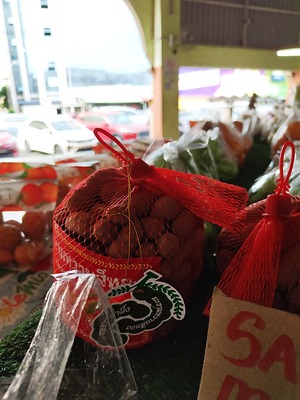


Tamarind Fruit
Estimated Inventory, 5 lbs : 2.96
This item was last sold on : 07/29/25
Description/Taste
Tamarind is comprised of bean-like shaped pods with a cinnamon-brown to clay-colored external appearance. Inside the pods, the fruit's flesh is tender, succulent, and green, with a highly acidic flavor when young. Its underdeveloped seeds are soft and white. As the fruit matures, the pod becomes brittle. The flesh begins to dehydrate to a paste-like form and takes on a dark brown appearance, losing its acidic punch and becoming sweeter. It is at this stage of maturity that it is most often used for culinary purposes. The seeds also change in both color and texture, becoming flat, hard, and glossy brown.
Seasons/Availability
Tamarind is available fresh from late spring to early summer.
Current Facts
The botanical name for Tamarind is Tamarindus indica, and it belongs to the Leguminosae family. Tamarind is one of the most widely distributed fruit trees in the tropics and can grow up to 30 meters tall. Though it originated in Africa, this tree flourishes in India, where it’s also referred to as Imli, Tetuli, Ambli, Koya, and Puli. The Tamarind tree and its byproducts have many functional uses. Its bark can be converted into timber, textiles, fuel, and fodder. Its wood can be used to construct furniture, wheels, canoes, boats, toys, and printing blocks. The leaves of the tree produce a yellow dye that turns wool red and indigo-dyed silk green. Tamarind seeds can also be converted into a food additive called jellose that increases the viscosity and texture of foods like ice cream, mayonnaise, and cheese. Tamarind seed oil has been used to make varnish for painting idols and lighting lamps.
Nutritional Value
Tamarind is high in calcium, fiber, and magnesium, nutrients that are essential for bone health, nerve and muscle function, digestion, blood sugar control, and heart health. Tamarind is particularly high in an antioxidant called beta-carotene, which is important for eye health. Tamarind contains flavonoids, a nutrient that may help regulate cholesterol levels. Tamarind extract may possess antifungal, antiviral, and antibacterial properties that can be used to treat heart disease, cancer, and diabetes. Tamarind has been used in traditional Indian, African, Pakistani, Bangladeshi, and Nigerian medicine to treat ailments like abdominal pain, diarrhea, dysentery, fever, inflammation, and eye disease. The bark and leaves of the Tamarind tree are also used to promote wound healing.
Applications
The leaves, flowers, and fruit of the Tamarind tree are all edible, though the fruit is the most commonly consumed part. Tamarind can be consumed in several ways: eating the raw pods, removing the shells and seeds and pressing the pulp into blocks, or boiling down the pulp to create a concentrate. The fruit is commonly mixed with sugar and water to create a cooling beverage. Tamarind pulp is often used to make chutney, meat sauces, and pickled fish. In Southeast Asia, Tamarind is combined with chiles to make a paste for grilled fish or chicken. It is one of the main ingredients in a Filipino soup called sinigang and a dish called saunth chutney paired with fried snacks in India and Pakistan. Tamarind is used to make agua fresca, a popular drink in Latin America, and sharbat, a chilled cordial eaten during Ramadan. Tamarind pulp is used in various confections like ice cream, sherbet, and candy. It pairs well with the flavors of shrimp, pork, lemon, lime, cilantro, shallots, garlic, coconut milk, peanuts, and serrano chiles.
Ethnic/Cultural Info
According to Indian Brahmasamhita Scriptures, Tamarind was likely cultivated in Egypt as early as 400 BCE. Somewhere between 370 and 287 BCE, the Greek philosopher and student of Aristotle, Theophrastus, mentioned Tamarind in his writing. In Southeast Asia, Tamarind is referred to as “asam”, the Malay word for sour, and is often used in sauces, soups, and noodle dishes. Tamarind’s popularity transcends into North America primarily due to the influx of immigrants that have migrated there. In the United States, Tamarind is one of the main ingredients in Lea & Perrins Worcestershire sauce. In Mexico, it's an additive in beverages and sour candies.
Geography/History
The Tamarind tree is native to tropical Africa and now grows in tropical and subtropical climates throughout Asia, the Pacific Islands, and the Americas. Tamarind can be found growing on wild trees, particularly in the savannahs of Africa. It’s also grown commercially in tropical gardens, particularly in India. Tamarind spread worldwide when brought to Asia, most likely in the first millennium BCE. In the early 1600s, it was transported to the Western Hemisphere, where it became popular in Mexico and the Caribbean. These days, Tamarind is commonly found in gardens and grocery stores, especially in South and Southeast Asia, Latin America, and Africa. Outside these regions, it may be purchased from specialty stores and farmers markets during peak season.
Featured Restaurants
Restaurants currently purchasing this product as an ingredient for their menu.
| Green Acres Campus Bar | San Diego CA | 858-450-9907 |
| Mothership | San Diego CA | 858-342-3609 |
| Pizzeria Luigi | San Diego CA | 610-539-7025 |
Recipe Ideas
Recipes that include Tamarind Fruit. One

















